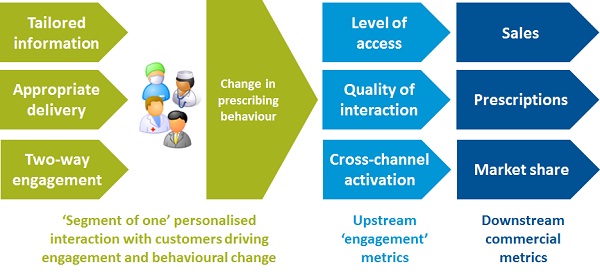Adapting multi-channel around your customers

In the second part of this series looking at multi-channel marketing in the pharma industry, Quintiles explores how to dynamically adapt campaigns in the right direction by measuring early success markers and implementing effective feedback loops.
(Continued from "Planning customer-centric multi-channel marketing")
In the first part of this three-part series, we introduced a different view of multi-channel marketing – one where its strength is in planning to deliver highly personalised engagement to each individual customer, defined as the 'segment of one'. By ensuring each receives exactly the information they need, via appropriate channels and at a time that is convenient, much stronger and mutually beneficial relationships can be built.
However, even a perfectly planned strategy aligned with customer markets is not static, and it is important to measure and adapt on an on-going basis. Here, we assess how to measure whether your campaign is successful and how to develop a constructive feedback loop that allows integrated-channel solutions to scale up in the right way.
Adapting correctly when the only constant is change
Whilst careful consideration of both external (market forces and customer-centric aspects such as business value, information needs and preferential engagement routes) and internal (brand and portfolio positioning / complexity of messages and available skills / expertise) factors are critical to getting your multi-channel campaign off to a good start, preparing for adaptation is equally vital. This includes tempering management expectations around 'getting it right the first time,' and instead ensuring they see the start as just that – an initial pilot approach that will be adjusted and scaled over time.
After all, local environments for brands can shift overnight as new products are launched, generics enter or payers react to new evidence. Likewise, the information that your customers require and the way in which they wish to receive it can change quite rapidly, even in the absence of sweeping market changes, as new technologies influence their working practice. Consider, for example, the infiltration of smartphones over just a few years and how few physicians are now without them. Equally, internal capabilities do change over time, which can shape commercial activities just as much.
Amidst the only constant being change, the key is tracking the right metrics to inform change and ensure a strong customer-centric focus is at the heart of any modification.
Measuring the right metrics for adaptation
So here is the real challenge with running dynamic multi-channel campaigns – how do you know when you need to change or scale up and in what areas?
It all comes down to measurement, and the most important question is 'what should we be measuring?' The purist will, of course, say 'sales,' and commercial teams are often armed with sophisticated dashboards that can track sales, prescription or market share outputs against simple inputs, such as number of contacts, proportion of targets 'seen' and volume of engagement activity.
These systems are useful as improved sales is the ultimate endpoint, but there are earlier markers and a wide range of process metrics, which are equally useful at identifying whether integrated-channel solutions are really engaging in a customer-centric way and can therefore be treated as 'leading markers' for downstream changes in prescribing habits, as illustrated in figure 1.

Decreasing levels of access to doctors, and other key stakeholders, by direct contact has historically played a role in driving the development of alternative engagement channels through multi-channel marketing. If a particular stakeholder is an important customer for your brand, you need to find a way to engage with them and it is not uncommon to find that, for example, doctors who will never see a sales representative are not averse to engagement through other channels, such as remote detailing or online initiatives. In addition, the duration of the right engagement is often longer where it is on terms that suit the recipient.
Quality of interaction
Quality of interaction, or the degree to which the customer actually engages with the information offered, is absolutely vital for changing downstream behaviour. For example, detail follow-ups (DFUs) can be used to provide such qualitative feedback on direct customer interaction above and beyond simple quantitative metrics around call rates. Equally, for online initiatives, metrics such as duration of interaction are more powerful for assessing quality than simple metrics such as website hits or social media followers. Also, satisfaction surveys or other online questionnaires can be used to capture customer views and feedback. Ultimately, if the right information is provided in a way and at a time that suits the customer, the quality of interaction is likely to be high.
Cross-channel activation
Cross-channel activation is the essence of good multi-channel marketing – the fact that using any single channel in isolation might not engage the customer in the right way, but by bringing them together the sum is more than the parts. Think, for example, of a doctor taking part in some professional development through an eLearning platform that provides CME credits, which then results in them taking part in a peer-to-peer webinar around a particular disease area and, ultimately, requesting direct contact with a representative for specific product information. This is a good example of customer-centric pull marketing that utilises multiple channels.
As a final cautionary note around success metrics, whether they are traditional or more 'customer-focussed', be wary of using benchmarks derived from different channels or markets. If all you have is a benchmark for sales rep engagement, it might not prove useful for measuring other channels, so prior experience and trends over time are as important as absolute metrics.
Efficient feedback loops drive successful adaptation
Establishing appropriate monitoring systems to assess the success of your multi-channel campaign on a dynamic basis is just as, if not more, important as planning the right initial approach. However, unless the right metrics are being assessed vital information might be lost that can provide early warning of failing activities that can undermine commercial success. So, be open-minded to what can be measured through newer channels.
Such tracking systems have to take account of how well the campaign is working from the perspective of the customer – your 'segment of one'. If your customers are not responsive to your approaches and are not being driven to seek further engagement with your brand then the right information is not being delivered on their terms.
Measuring this and listening to customer feedback is critical for early adaptive response, by flexing the channel approach, messaging or way in which information is delivered. In the final part of this series, we explore further some of the critical success factors relating to these.
The final part of the series, looking at critical success factors for implementing multi-channel campaigns, can be viewed here
About the authors:
Liz Murray is Multi-Channel Director, EMEA for Quintiles. She has prior experience working both within large pharma at Pfizer, where she held a variety of commercial roles, and within the NHS. Liz has an MBA from Manchester Business School.
Matthew McCarty is Senior Director for Quintiles Communications and joined the organisation after 11 years of experience running a business which delivered multi-channel communications solutions for customers across a number of industries including healthcare.
For more information on how Quintiles can provide integrated-channel solutions please visit www.quintiles.com/services/capabilities/product-marketing/brand-communications.
What are the key success metrics in multi-channel marketing?












